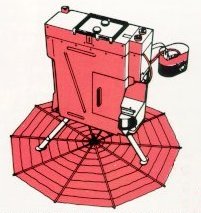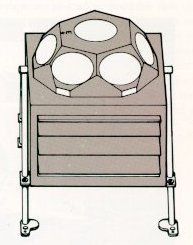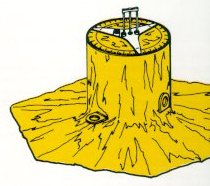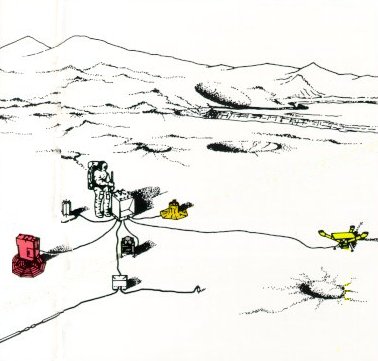Apollo Expeditions to the Moon
ALSEP: Scientific Station on the Moon
Although the Apollo astronauts could stay on the lunar surface
for only a few days, scientists wished to make some kinds of
observations over a period of weeks or even years, if possible.
The solution was to have the astronauts set up an unmanned,
automatic scientific station called ALSEP (Apollo Lunar Surface
Experiments Package). An ALSEP was emplaced at each landing
site, beginning with Apollo 12.
| | |
An ALSEP is a group of geophysical instruments arrayed about
a central station, as in the accompanying sketch. Each ALSEP
has a different set of experiments.
Power is supplied by a Radioisotope
Thermoelectric Generator. Radio communication for the
transmission of experiment data and the receipt of instrument
adjustment commands is maintained through a rod-shaped
antenna pointed in the Earth's general direction.
|
Each ALSEP can send about 9 million instrument readings a
day. With five ALSEPs operating simultaneously, a staggering
amount of information has already accumulated. An unexpected
bonus has been the unusually long lifetimes of the ALSEP units.
Originally designed for one year of reliable operation, all were
still sending useful data five years after Apollo 12.

|
The Suprathermal Ion Detector Experiment
(SIDE) measures the energy and
mass of the positive ions that result
from the ionization of gases near the
lunar surface by the solar wind or ultraviolet
radiation. The Cold Cathode
Gauge Experiment (CCGE) measures
changes in the extremely low concentrations
of gas in the lunar atmosphere.
The electronics for the CCGE are housed
in the SIDE.
|

|
The Solar-Wind Spectrometer experiment
uses seven Faraday-cup sensors to measure
the energy spectra of charged particles that
strike it from various directions. Because the
Moon, unlike the Earth, is not protected from
the solar-wind plasma by a magnetic shield,
the instrument can detect subtle variations in
the wind's intensity and direction.
|

|
Lunar Surface Magnetometers, operating
at three ALSEP stations, have simultaneously
measured the global response of the Moon
to fluctuations in large-scale solar and
terrestrial magnetic fields. By considering
these responses in conjunction with the freespace
magnetic data from the lunar satellite,
Explorer 35, scientists have estimated rock
temperatures (which affect electrical conductivity)
deep in the lunar interior.
|

|
The Passive Seismic Experiment uses four
extremely sensitive seismometers to measure
lunar surface vibrations, free oscillations,
and tidal variations in surface tilt.
Three long-period seismometers are mounted
orthogonally to measure wave motions
with periods between 1/2 and 250 seconds,
while the short-period seismometer measures
vertical motions with periods between
1/20 and 20 seconds. The electronics are
housed in the ALSEP central station. The
thermal shroud isolates the sensor and a
patch of ground 5 feet in diameter from
the temperature extremes of the lunar day
and night.
|
|





